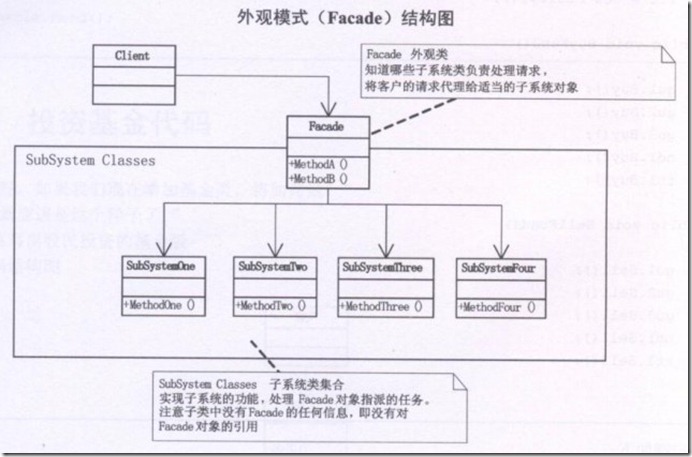重点概念回顾
1.为子系统中的一组接口提供一个一致的界面,此模式定义了一个高层接口,这个接口使得这一个子系统更觉容易使用。
2. 即使不知道外观模式也一定使用过外观模式,他完美的体现了依赖倒置(面向接口编程)原则和迪米特法则(功能松耦合)的思想,十分常用。
3. 外观模式的核心是,通过将分散的功能包含在外观类中,从而提供一致的操作接口,封装实现,起到了松耦合的目的
4. 在设计的初期阶段,应该要有意识的建立层次上的分离。
5. 可以为封装复杂的接口,也可以为封装众多功能的接口,使用外观模式。
6. 外观模式就是封装复杂。
演示例题
using System; using System.Collections.Generic; using System.Text; namespace 外观模式 { class Program { static void Main(string[] args) { Facade facade = new Facade(); facade.MethodA(); facade.MethodB(); Console.Read(); } } class SubSystemOne { public void MethodOne() { Console.WriteLine(" 子系统方法一"); } } class SubSystemTwo { public void MethodTwo() { Console.WriteLine(" 子系统方法二"); } } class SubSystemThree { public void MethodThree() { Console.WriteLine(" 子系统方法三"); } } class SubSystemFour { public void MethodFour() { Console.WriteLine(" 子系统方法四"); } } class Facade { SubSystemOne one; SubSystemTwo two; SubSystemThree three; SubSystemFour four; public Facade() { one = new SubSystemOne(); two = new SubSystemTwo(); three = new SubSystemThree(); four = new SubSystemFour(); } public void MethodA() { Console.WriteLine("\n方法组A() ---- "); one.MethodOne(); two.MethodTwo(); four.MethodFour(); } public void MethodB() { Console.WriteLine("\n方法组B() ---- "); two.MethodTwo(); three.MethodThree(); } } }
冯瑞涛







【推荐】国内首个AI IDE,深度理解中文开发场景,立即下载体验Trae
【推荐】编程新体验,更懂你的AI,立即体验豆包MarsCode编程助手
【推荐】抖音旗下AI助手豆包,你的智能百科全书,全免费不限次数
【推荐】轻量又高性能的 SSH 工具 IShell:AI 加持,快人一步
· 如何编写易于单元测试的代码
· 10年+ .NET Coder 心语,封装的思维:从隐藏、稳定开始理解其本质意义
· .NET Core 中如何实现缓存的预热?
· 从 HTTP 原因短语缺失研究 HTTP/2 和 HTTP/3 的设计差异
· AI与.NET技术实操系列:向量存储与相似性搜索在 .NET 中的实现
· 周边上新:园子的第一款马克杯温暖上架
· Open-Sora 2.0 重磅开源!
· 分享 3 个 .NET 开源的文件压缩处理库,助力快速实现文件压缩解压功能!
· Ollama——大语言模型本地部署的极速利器
· DeepSeek如何颠覆传统软件测试?测试工程师会被淘汰吗?
2008-12-01 silverlight, 双击事件
2008-12-01 silverlight 2 系统对话框
2008-12-01 silverlight click 事件委托是 RoutedEventHandler